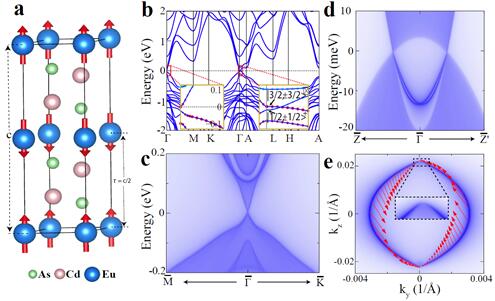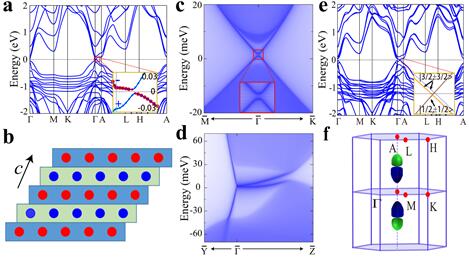The discovery and definition of new states of state play an important role in condensed matter physics. Topological semimetal is a new class of topological quantum states different from topological insulators. It is one of the hot research fields of condensed matter physics. According to the degeneracy and distribution of the magnetic monopole in the momentum space, the topological semimetal can be subdivided into Dirac semimetal, foreign semimetal, node line semimetal and multiple degenerate point semimetal. At present, research on Dirac semimetals has focused on non-magnetic materials (Physical Review B 85, 195320 (2012); Physical Review B 88, 125427 (2013); Physical review letters 113, 027603 (2014)). Considering the existence of abundant magnetic materials in nature, it is urgent and necessary to define and find Dirac semi-metals in magnetic materials. In 2016, Tang Peizhe, Zhou Quan, Xu Gang and others from the Shoufu University Zhang Shouyi Group first defined and predicted an antiferromagnetic Dirac semi-metallic material CuMnAs (Nature Physics 12, 1100 (2016)).

Figure 1: (a) Crystal structure of the antiferromagnetic ground state of EuCd2As2; (b) Electronic structure of EuCd2As2 and antiferromagnetic Dirac semimetal state; (c)- (e) Projected state density of EuCd2As2, Fermi arc And its spin distribution.Figure 1: (a) Crystal structure of the antiferromagnetic ground state of EuCd2As2; (b) Electronic structure of EuCd2As2 and antiferromagnetic Dirac semimetal state; (c)- (e) Projected state density of EuCd2As2, Fermi arc And its spin distribution.
According to the symmetry requirements and first-principles calculations provided by theoretical analysis, Xu Gang et al found that the interlayer antiferromagnetic material EuCd2As2 (Fig. 1a) is likely to be an ideal antiferromagnetic Dipole under the fourth type of magnetic space group. Lak semi-metal - only a pair of Dirac points through the Fermi level (Figure 1 b, d). They found that antiferromagnetic topological insulators—an axial insulator (Fig. 2a) and antiferromagnetic triple degenerate point semimetals—are possible in EuCd2As2 by proper magnetic moment direction regulation or symmetry breaking. (Figure 2 e, f) and other novel topological states. Therefore, the three-dimensional antiferromagnetic material EuCd2As2 provides an ideal platform for the study of various antiferromagnetic topological states.
After the publication of the research results, it quickly attracted the attention of many experimental groups and carried out related experimental work, which has been cited more than 10 times. It is particularly worth noting that Ding Hong and Qian Tian of the Institute of Physics of the Chinese Academy of Sciences have used the angle-resolved photoelectron spectroscopy technique to observe the linear Dirac dispersion in EuCd2As2, which provides important experimental evidence for the realization of the Dirac semi-metallic state in EuCd2As2.
Recently, Professor Xu Gang of the National Pulse Strong Magnetic Field Science Center of Huazhong University of Science and Technology and his collaborators studied the Dirac semi-metallic state in all magnetic space groups. They found that there is no Cramer degenerate and Dirac semimetal in the first type of magnetic space group, and Dirac semimetals can exist in some of the second and third types of magnetic space groups. The experimentally confirmed Na3Bi, Cd3As2, etc. belong to The second type of magnetic space group, CuMnAs belongs to the third type of magnetic space group. Further research finds that for the centrally symmetric fourth-class magnetic space group, although there is no simple time inversion operator T, the space inversion operator P and the non-simple time inversion operator T'=Tτ (τ is connected up and down The interaction of the translational vectors of the spin lattice can still guarantee the singular degeneracy at any point k, and the Dirac semimetal can also be realized under the protection of appropriate rotational symmetry: the cloth in the magnetic space group On the high symmetry axis in the Liyuan area, the rotational symmetry Cn(n=3, 4, 6) can protect the stable Dirac point; at the high symmetry point of k·τ=0, 2 degrees, 4 degrees and The 6-degree rotational symmetry also protects the stable Dirac point; other than the other points, the Dirac point cannot exist. The theoretical work successfully extended the concept of Dirac semi-metal to the fourth type of magnetic space group, systematically studied the symmetry requirements and distribution of Dirac points, and greatly promoted the search range of Dirac semi-metal, and The search for antiferromagnetic Dirac semi-metals provides a clear roadmap to help advance research in the field of topological semi-metals.

Figure 2: (a) an antiferromagnetic topological insulator obtained when
the magnetic moment is in the in-plane direction; (b) a schematic diagram
of two-dimensional Chen insulators alternately stacked in the c direction
to form an antiferromagnetic topological inulator, wherein the red and blue
spheres correspond respectively.The two-dimensional Chen insulator layer
with a number of 1 and -1; (c, d) corresponds to the projected state density
of the (001) and (100) surfaces of the antiferromagnetic topological insulator,
respectively;(e, f) respectively correspond to the damage.The inverse
ferromagnetic triple degenerate point semi-metallic band structure obtained
after spatial inversion symmetry and the corresponding Fermi surface.
According to the symmetry requirements and first-principles calculations provided by theoretical analysis, Xu Gang et al found that the interlayer antiferromagnetic material EuCd2As2 (Fig. 1a) is likely to be an ideal antiferromagnetic Dipole under the fourth type of magnetic space group. Lak semi-metal - only a pair of Dirac points through the Fermi level (Figure 1 b, d). They found that antiferromagnetic topological insulators—an axial insulator (Fig. 2a) and antiferromagnetic triple degenerate point semimetals—are possible in EuCd2As2 by proper magnetic moment direction regulation or symmetry breaking. (Figure 2 e, f) and other novel topological states. Therefore, the three-dimensional antiferromagnetic material EuCd2As2 provides an ideal platform for the study of various antiferromagnetic topological states.
After the publication of the research results, it quickly attracted the attention of many experimental groups and carried out related experimental work, which has been cited more than 10 times. It is particularly worth noting that Ding Hong and Qian Tian of the Institute of Physics of the Chinese Academy of Sciences have used the angle-resolved photoelectron spectroscopy technique to observe the linear Dirac dispersion in EuCd2As2, which provides important experimental evidence for the realization of the Dirac semi-metallic state in EuCd2As2. .
The research results are published in Phys. Rev. B 98, 201116(R) under the title "Dirac semimetal in type-IV magnetic space groups". Dr. Hua Guiyuan from the School of Physics and Nie Simin from Stanford University are the first authors of the paper. Professor Xu Gang from the Strong Magnetic Field Center, Professor Yu Rui from Wuhan University, and Dr. Song Zhida from the Chinese Academy of Sciences are co-authors. Professor Yao Kailun from the Center for Strong Magnetic Fields participated in the study. The work was supported by the National Key R&D Program and the National Natural Science Foundation of China.
Article link:https://journals.aps.org/prb/abstract/10.1103/PhysRevB.98.201116